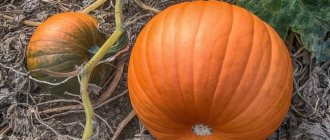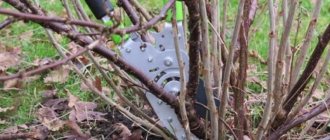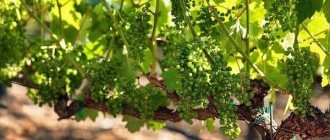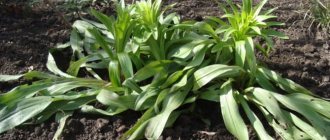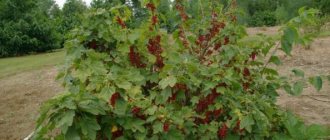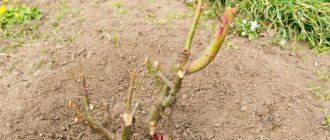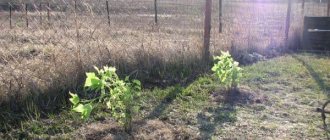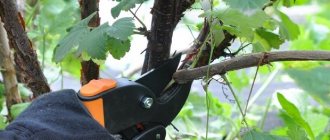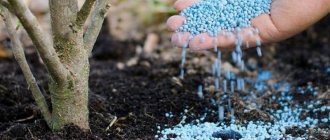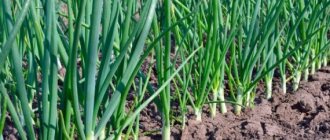Currants grow everywhere in our country, and many summer residents do not pay due attention to feeding this shrub.
Yes, currants bear fruit regularly and in almost any conditions, but with the help of fertilizers you will not only increase the yield of berries, but also increase the plant’s immunity. Dear readers!
For you, we have created communities on social networks in which useful articles and interesting ideas are published several times a day! Subscribe and receive useful content in a convenient format! In this article we have collected all the most important information about spring feeding of currants.
When to feed currants in spring
After winter, currants are fed several times. The very first fertilizing is carried out as soon as the snow melts and positive temperatures are established.
Then additional feeding is carried out before and after flowering.
If for the first time we stimulate the growth of leaves and shoots, the growth of skeletal branches and green mass, then subsequent feedings are needed for fruit formation.
What feeding methods are there?
There are two ways to feed currant bushes in spring: root and foliar. The first method is the simplest and most common. It is produced by adding organic or mineral fertilizers to the soil in the root zone. Gradually dissolving under the influence of moisture contained in the soil and incoming atmospheric moisture, the fertilizer passes into a liquid state and is then absorbed by the root system of the bush. Such fertilizing is called slow, since the process of their decomposition and absorption of nutrients by plants occurs over a fairly long period of time.
Adding them in already dissolved form can increase the rate at which plants absorb nutrients. To do this, the fertilizer is dissolved in water before application. In this form, the plant absorbs it much more intensely, and the result is noticeable faster.
Another way to stimulate the plant is foliar feeding. For a long time it was believed that nutrients were absorbed only by the roots, but this is not true. Leaves and shoots cope with this task no worse. Foliar feeding is carried out by spraying plants with aqueous solutions of fertilizers. Thus, nutrients reach the desired part of the plant much faster, which stimulates its increased growth.
How to fertilize currants in spring
Shrubs can be fed in two ways: by pouring liquid fertilizer at the root or by spraying the shoots and leaves of the plant. Let's consider what compositions need to be used for each method.
Root feeding
Root feeding is the main method of fertilizing currants. Watering shrubs is similar to feeding trees. This means that you need to pour the nutritional mixtures not at the root, but at a distance of about 20 cm from it.
The second method of root feeding is to embed dry components into the soil under the bush. The depth of application of fertilizer is 20-30 cm to nourish the roots. In this way, it is good to introduce organic matter, which will be processed for a long time and gradually nourish the plant.
Foliar feeding
This is a normal spray. Many summer residents are accustomed to the fact that currants can only be sprayed against diseases and pests. But foliar feeding is very effective if you need to urgently add some microelements.
Growth stimulants are also usually applied foliarly.
Spraying is also effective when it is not possible to water the bush with a nutrient solution. For example, there are long rains, and the soil under the currants is wet all the time. Then, in order not to cause rotting of the roots, the necessary elements are introduced by spraying.
How to apply fertilizer correctly
Liquid fertilizers are applied into grooves or holes about 10 cm deep at a distance of 3-4 cm from the bush. Before the procedure, the bush is watered; no substances are added to the dry soil. When using chemical fertilizers, it is recommended to wear gloves to avoid burning your hands. Also, you should not exceed the indicated dose or fertilize currants too often, otherwise it will react negatively to an excess of vitamins and minerals.
Experienced summer residents advise avoiding contact of liquid root fertilizers with exposed parts of the plant - burns are possible .
What mineral fertilizers should I use to feed currants in spring?
The most effective are mineral fertilizers. In them, the substances necessary for currants are in maximum concentration.
Nitroammofoska
This is a complex fertilizer that contains potassium, nitrogen and phosphorus in equal parts. 15 grams of the drug is enough for 1 plant. The granules can be embedded in the soil, or they can be dissolved in water and watered over the bush.
Urea (Ammonium nitrate)
These are nitrogen fertilizers and need to be used only once per season. Urea contains more nitrogen, so it is better to use it. 1 matchbox per bush is enough.
Superphosphate
A source of phosphorus that plants need. Feeding with superphosphate is carried out once or twice a season.
Potassium sulfate
Saturates currants with potassium. Typically, potash fertilizers are mixed with phosphorus fertilizers and applied together. The plant needs this mixture to set fruit.
Humates and growth stimulants
They cannot be called complete fertilizers, but they contain humic acids and other useful substances that currants also need.
Humate (Gumi, products under the Agricola brand, etc.) can be added simultaneously with mineral complexes.
How to feed currants in the spring for a good harvest: options for effective spring fertilizers
Naturally, before buying and fertilizing, you need to figure out what (what fertilizers) can best feed currants in the spring.
As with many other crops, mineral and organic fertilizers are used to feed currants.
Next, we will take a closer look at what fertilizers can be used, as well as how to combine them.
Note! You should not apply potassium chloride and phosphorus fertilizers ( for example, potassium chloride, potassium salt and diammophos) under white and red currants (but under black currants you can!). Such fertilizing can cause the plant to become infected with chlorosis.
By the way! Almost all berries are very sensitive to excess chlorine, in particular red and white currants, wild strawberries, grapes, and to a lesser extent, black currants and gooseberries.
Nitrogen fertilization
Remember! Apply only once, in early spring .
Mineral nitrogen fertilizers:
- Urea (Urea) - 46% nitrogen (10-15 grams per 10 liters of water or per 1 sq.m);
- Ammonium nitrate - 33% nitrogen (15-20 grams per 10 liters of water or per 1 sq.m);
Organic nitrogen fertilizers:
- chicken manure (usually 1 to 20 with water, or you can simply scatter it in a circle near the trunk);
By the way! Please note that purchased bird droppings contain the entire complex of macroelements, as well as some microelements.
- infusion of cow dung or mullein (1 to 40);
- green fertilizer (nettle infusion).
It is also very good to mulch the tree trunk circle with compost or humus.
Complex mineral nutrition
It is very convenient to use complex mineral fertilizers, which contain all macroelements.
So, currants in the spring (before flowering) can be fed with the following fertilizers:
- Nitroammophoska (nitrogen, phosphorus, potassium - 16% each). Prepare the solution at the rate of 20-30 grams per 10 liters of water. Pour about 5 liters under an adult bush.
Video: feeding currants in spring with nitroammophos and other tips for spring care of shrubs
- Diammofoska - 10% nitrogen, 26% phosphorus and potassium each (20-30 grams per 10 liters of water).
Note! These fertilizers do not contain any microelements, and it is highly advisable to add them. Therefore, it is highly recommended to add humates to the solutions, which are described in more detail below, in the last paragraph.
Mineral and organic potassium-phosphorus fertilizer
Suitable for feeding before and after flowering, as well as in autumn.
Mineral:
- Superphosphate - nitrogen 6-9%, phosphorus - 26-30% (20-30 grams).
Advice! The site has a separate article on how to use superphosphate .
- Potassium sulfate (potassium sulfate) - 46-52% potassium (15-20 grams).
everything ( superphosphate and potassium sulfate) in 10 liters of water, and then pour 5 liters of solution under each bush.
By the way! Instead of potassium sulfate (potassium sulfate), you can use potassium salt.
Attention! This is a chloride fertilizer, which means it is not suitable for white and red currants (black currants can be fertilized).
Or potassium nitrate (Nitrogen -13.6, Potassium 46%).
It is also very convenient to use potassium magnesium , which, in addition to potassium, also includes such an important trace element as magnesium.
Organic potassium-phosphorus supplement
If you are a supporter of organic farming use wood ash as a potash fertilizer by preparing a solution (or even better, an infusion extract): 100-200 grams of ash per 10 liters of water.
As for phosphorus , it is found in bone or fish meal (100-200 grams per 1 sq.m.).
Video: phosphorus fertilizer for shrubs (bone meal)
Fast-absorbing phosphorus fertilizer
Suitable for feeding before and after flowering (during fruiting).
To make an easily digestible infusion of superphosphate for spring feeding of currants you need:
Take potassium monophosphate , dissolve in water and fertilize. However, it cannot always be found in the store, and it costs a lot.
Or:
- 1 kg of double superphosphate into 5 liters of boiling water;
- after the water has cooled, add 0.5 liters of 9% vinegar;
Acidifying the water will convert the calcium phosphate into a more soluble form.
- Let sit for 12-24 hours, shaking and stirring occasionally.
- Add another 5 liters of water, bringing the total volume to 10 liters.
- Then dilute 1 liter of the resulting superphosphate infusion with 10 liters of water (1 to 10).
- Feed.
Advice! The remaining phosphorus sediment can be dug under fruit trees.
Autumn potassium-phosphorus fertilizing (after harvest)
An excellent option for feeding currants after fruiting and harvesting (i.e. at the end of summer - closer to autumn) can be the following combinations of mineral and organic fertilizers.
By the way! The website has a detailed article on how and what to feed currants after fruiting and harvesting (in autumn).
First option:
- superphosphate - nitrogen 6-9%, phosphorus - 26-30% (20-30 grams per 10 liters of water).
Or double superphosphate (nitrogen 7.5-10%, phosphorus 46%). But the dose should be reduced by 1.5-2 times.
- potassium sulfate (potassium sulfate) - 46-52% potassium (15-20 grams per 10 liters.
Second option:
- Nitroammophoska - 2 tbsp. spoons (25-30 grams).
- Wood ash - 1 cup (100-200 grams).
Third option:
- Diammofoska - 10% nitrogen, 26% phosphorus and potassium each (20-30 grams).
Fourth option:
- Potassium monophosphate (Phosphorus - 50%, potassium - 33%) - 15-20 grams;
Dissolve everything, mix in 10 liters of water and pour 5 liters of solution under each bush.
Ready-made fertilizers for currants
If you don’t want to bother (you’re a “lazy” summer resident), then you can buy one of the special complex fertilizers for currants (berry bushes), which already contains all the macro- and microelements (apply and dilute everything according to the instructions on the packages):
- Gumi-Omi “Berry” for currants, strawberries, raspberries and other berry bushes (based on chicken manure).
- long-acting fertilizers are especially popular (granular; it is advisable to apply them dry into holes along the diameter of the bushes, and then water them). For example, " Berry Bushes " from Fusco .
- and others.
Fertilizers with humates and microelements
It is very good to use humates , which contribute to better absorption of mineral fertilizers. Therefore, you can first prepare a solution of humate (for example, potassium humate ), and then add complex mineral fertilizer to it, for example, the same Nitroammofoska.
By the way! Nowadays, humates are initially added to some complex mineral fertilizers. For example, “ Krepysh” from Fasco with potassium humate and microelements.
In general, to feed currants it is very convenient to use ready-made cocktails from the most important microelements such as Humate +7 Iodine.
Folk remedies
Among folk remedies, feeding currants with yeast is very popular.
This fertilizing is best done before flowering.
- 100 g of fresh yeast (or 30-35 grams of dry, i.e. ratio 1 to 3) and 100 grams of sugar are dissolved in 5 liters of warm water and left for 1-3 days (for the fermentation process to begin), while not forgetting Stir occasionally. Then the resulting mother solution is diluted 1 to 10 with water, poured into a watering can and watered abundantly (pouring about 5 liters) each plant.
Important! Adding yeast to the soil negates the presence of potassium in the soil (dissolves it), so immediately after a week add a potassium supplement, for example, wood ash or potassium sulfate (potassium sulfate).
- Potato peelings (dry, frozen, fresh) are often used as a folk remedy for fertilizing currants in the spring . The advantage of this feeding is the high content of starch in the peelings, which is necessary for plant growth. Moreover, you can either prepare an infusion (fill a bucket 2/3 full with peelings and pour boiling water over it, leave for 2-3 days), or simply spread the tops under the bushes in early spring or autumn, and even better, bury them around the perimeter of the crown.
It is necessary to add drops so that the peelings rot faster and release their beneficial substances to the currants.
If you try to fertilize the bush with purchased starch , then there will be no such effect.
Video: feeding currants in early spring with potato peelings
Application of organic fertilizers
Organic matter can also be used to feed currants. Let's look at the most popular formulations.
Rotted manure
NOTE! Fresh mullein cannot be used. The manure must rot!
The proportion of preparation of the working infusion is 1 to 5.
Rotted manure is good because it stimulates beneficial microflora in the soil and generally improves the soil structure.
Chicken droppings
Chicken droppings have a similar effect.
To prepare a solution from this product, fresh droppings are poured with water and left in a barrel for 5-7 days. Then the resulting concentrate is diluted in a ratio of 1 to 10 (12 is possible) and the bushes are watered.
IMPORTANT! Watering with organic matter should be carried out in the circle around the trunk, and not at the root. The consumption rate of the drug is from 5 to 10 liters per bush, depending on the size.
Find more information about using manure as fertilizer in our article “Chicken manure as fertilizer: how to dilute and use it to feed plants.”
Ash
Wood ash is a source of potassium. You can prepare fertilizer for currants in this way: mix 5 liters of ash and the same amount of water in a bucket. The solution is left for two days, stirring occasionally. 10 liters of concentrate is enough for 100 liters of water.
The consumption rate of the working solution is 6 buckets for an adult bush, half a bucket for a young bush.
Read about all the beneficial properties of ash and methods for preparing ash infusion in our article “Feeding seedlings with ash, how to feed tomatoes, peppers and more.”
Types of fertilizers and fertilizing to increase yield
Mineral fertilizers
- Superphosphate is a nutrient mixture with a complete mineral complex for fruit and berry crops.
- Calcium nitrate – contains calcium necessary for plants.
- Ammonium nitrate is used in the initial phase of development in the spring and promotes active plant growth due to its high nitrogen content.
- The drug "Kemira - Lux" contains the required amount of nitrogen, potassium and phosphorus.
- The preparation “Pixa Super Compost” contains a large number of beneficial microorganisms and promotes the active growth and full development of plants.
- Urea is a drug with a high nitrogen content.
Effective fertilizer for currants - video
Organic fertilizers
- A solution of ten liters of water and one liter of chicken manure.
- A solution of one part mullein and five parts warm water.
- Herbal infusion of nettle stems and leaves (more than half a bucket) and water (to the top of the container). Infusion lasts six to seven days.
- A solution of one liter of bird droppings, fermented for one week, and two tablespoons of urea.
Complex fertilizing
- “Gumi - Omi Berry” - contains chicken manure, as well as all the macro and micro elements necessary for currants.
- “Nitroammofoska” - consists of equal amounts of nitrogen, potassium and phosphorus.
- "Kalimagnesia" - contains potassium and magnesium.
- "Diammofoska" - contains a minimum of nitrogen and a maximum of potassium and phosphorus.
- “Berry bushes” from “Fasco” is a mineral complex in granules to increase the yield of currants.
Folk recipes
Experienced gardeners recommend proven and tested folk fertilizing recipes to increase the yield of fruit and berry bushes.
Yeast
As a liquid nutritional supplement, use a solution prepared from warm water (ten liters), yeast (two hundred grams of fresh or seventy grams of dry), sugar (one glass). After infusion for forty-eight or seventy-two hours, each liter of fermented mixture is combined with ten liters of water and the crops are watered abundantly at the rate of five liters for each.
Potato peelings
During active growth, currant bushes require starch, which they can obtain from ordinary potato peelings. This organic material, unnecessary for humans, is used to prepare a natural infusion. A large container is filled to about seventy percent with purification, then hot water is added to the top and left in a room at room temperature for two to three days. Before use, filter the solution.
Milk serum
For irrigation, you can use a solution prepared from five liters of water and one and a half to two liters of whey. Each plant requires about one liter of useful liquid.
Banana peel
Banana peels are useful for feeding the bushes with potassium. The remains of seven to ten bananas are placed in a large bucket, filled with hot water and left for two days in a warm room to infuse. Used for irrigation.
Bread crusts
Currants respond well to “bread” watering. First, prepare a thick mixture - a base of equal parts water and bread crusts. After infusing for a week, ten liters of water are added to each liter of the mixture and the plants are watered at a rate of five to seven liters for each.
Herbal infusions
Herbal infusions give good results. They are prepared from various common plants - chamomile, wheatgrass, dandelion. To do this, you can place a large container in the garden plot (in direct sunlight), which is filled to the middle with herbaceous crops, and then filled with water and covered with a lid or thick film.
After the end of the fermentation process, which will last from seven to twelve days, the solution is filtered, water is added (in a ratio of one to ten) and the currants are watered.
To increase the yield of currants, as well as for the purpose of prevention from various pests before bud break, it is recommended to treat the berry area with boiling water using a watering can with a divider. Each bush will require about three liters of water with a temperature of about eighty degrees.
Feeding with folk remedies
Some summer residents prefer to use folk remedies. Such compositions can also be useful for feeding currants.
Potato peelings
Black currant responds well to fertilizing with peelings. This waste contains starch and a lot of other useful elements.
The fertilizing is prepared as follows: the peelings are poured with boiling water. Once the water has cooled, the peels are collected and finely chopped. Next, furrows or holes (up to 0.3 m deep) are dug under the currant bush. A five-centimeter layer of peelings is laid out on the bottom and sprinkled with soil. Pour a glass of ash on top and finally cover it with earth.
Green manure
It is best to use young nettle, but any herb will do.
The weeds are finely chopped, placed in a bucket or barrel and filled with water, adding half a kilo of sugar. After 2 weeks the concentrate is ready. The softened leaves are thrown away, and the remaining liquid is diluted 1 to 10 with water and watered over the currants.
Fermented bread
Fill a three-liter jar halfway with bread crusts, crackers and crumbs. Add water and leave to ferment for 2 weeks.
Then drain the liquid. This will be a concentrate for preparing a working solution (1 to 10 is prepared).
Fertilizer improves the soil structure and its properties.
Banana fertilizer
You will need banana peels. It is poured with hot water and left for 48 hours in a warm place. Then filter and water the bushes.
Stages of fertilizing
Spring feeding consists of 3 stages.
The first time the currants are fertilized is before the buds open. The temperature at this time is not lower than +6˚С. The first feeding may consist of complex or organic substances, which must contain nitrogen.
The second stage is carried out before flowering. It is usually carried out 2 weeks after the first one. The composition may include a small amount of nitrogen, but not more than other elements. To do this, use manure, which can be mixed with potassium sulfate.
The last feeding of currants is done without nitrogen. Phosphorus-potassium preparations and starch are used for it. At this stage, currants are fertilized to improve the quantitative and qualitative characteristics of the fruit.
Almost every gardener grows currants. It is useful to know how to properly care for this plant. A responsible attitude to fertilizing shrubs can give a rich harvest of unusually tasty berries.
Schemes and stages of spring feeding of currants
For a good harvest and strengthening the immunity of the bushes, currants need to be fed three times.
The very first time fertilizing is applied at the beginning of the growing season. They are guided by the buds on the shoots. As soon as they begin to swell, you need to apply nitrogen fertilizers (urea, ammonium nitrate, nitrophoska, chicken droppings, ammonia solution, etc.).
Recipe : Fill a matchbox of urea with a bucket of water and stir. Pour the resulting mixture into the bush.
The second time we add potassium-phosphorus mixtures to the diet. We recommend using ready-made complex formulations from or analogues (Yagodka, Kemira Lux).
Recipe : a tablespoon of potassium sulfate is diluted in water and applied under a bush.
It is recommended to carry out the third feeding two weeks after the second. It is best done foliar.
Recipe : half a matchbox of urea is dissolved in a bucket of water and sprayed on currant foliage.
Features of applying spring fertilizing
Several spring feedings promote enhanced growth of the fruit bush, active emergence of new shoots and green mass, as well as flowering and ovary formation. The future harvest directly depends on the timely application of fertilizers in the spring. To support garden crops, various types of industrial or home-made fertilizers are used.
When to fertilize currant bushes in spring
The first organic fertilizer (for example, rotted compost, humus or bird droppings) in the amount of eight to ten kilograms for each seedling is applied to the planting hole during planting. These reserves of nutrients will be enough for the plant for the first two years, when the currants will not yet bear fruit. In the third year, currants bear their first fruits, which means they actively select fertilizer reserves from the soil. From this period, it is necessary to feed the garden crop every year.
Important! When applying the first spring fertilizing, it is recommended not to rush, but to wait until the soil warms up to a temperature of seven to ten degrees Celsius. At lower soil temperatures, the roots of the currant bush will not be able to absorb fertilizers.
Main stages
The application of fertilizing in the spring depends on the development phase of the garden plant. Spring care begins with pruning bushes, loosening and weeding, and only then - additional nutrition.
- The first time fertilizer is applied at the beginning of spring, when the currants are just awakening. During this period, her kidneys swell. At this stage of development, the crop needs a large amount of nitrogen. You can use mineral or organic fertilizers in liquid form.
- The second time (after about fifteen days) - it is recommended to apply organic or complex fertilizers with the obligatory content of potassium and phosphorus, scattering them directly under the bush.
- The third time (after another fifteen days) - in the form of a liquid nutrient solution for spraying with any type of fertilizer.
Methods of fertilizing
There are two ways to apply fertilizing: root (watering directly under the bush) - the main and most common, foliar (spraying leaves) - additional.
With the root method of applying fertilizers, liquid and dry formulations are used. Solutions are quickly absorbed into the soil and immediately penetrate to the roots, and dry mixtures or granules first dissolve in wet soil (during rain or after watering).
Spraying is recommended only in established warm daytime weather and warm nights. Plants are fed by foliar method as needed. The leaves perfectly absorb nutrients along with an aqueous solution and respond positively to such fertilizing with enhanced growth and full development.
Important! Irrigation of the leaves of currant bushes is recommended only at night, after sunset. Wet foliage exposed to daytime sunlight can become scorched.
How to get a big harvest, what does it depend on?
In fact, the berry harvest depends not only on the quantity and quality of the applied nutrients. If you want the currant berries to be large and not resemble beads, the bushes must be trimmed, loosened the soil under them, regularly fed and watered, and also treated against diseases and pests.
Currants are a very tenacious crop. It will produce berries even when infected with glass beetles or gall aphids. But the harvest that healthy bushes will bring you cannot be compared. It's bigger and much tastier.
Fertilizing currants in spring: valuable tips
There are two ways to deliver nutrients to plant tissue - root and leaf.
In spring, fertilizers are usually applied by the root method, since the leaf apparatus of currants is still poorly developed and is unable to absorb active substances well.
Fertilizers are added to the soil in the form of an aqueous solution or scattered under plants and then incorporated.
I always choose the option of applying fertilizer depending on the initial soil moisture in the berry garden.
In wet spring, after the dense snow cover has melted, additional water is not only unnecessary for the bushes, but even harmful - the suction roots can get wet and rot.
So I do all the fertilizing in dry form:
- At a distance of 30-40 centimeters from the plant, I draw a furrow in a circle. For black currants, its depth should be 10-15 centimeters, and for colored currants - 20-30 centimeters (it has deeper roots).
- I distribute the granules evenly along the bottom of the groove and cover them with soil.
- I mulch the tree trunk circle with garden compost, humus or peat.
It is better not to embed organic materials into the soil, but to retreat 10 centimeters from the root collar and lay them in a layer of 1-2 centimeters around the bushes. It is advisable to cover them on top with straw or hay. With rain, organic minerals will gradually reach the currant roots, which will prevent them from burning.
In our Kaliningrad region, a dry spring is very rare, but it still happens. In such circumstances, I apply fertilizers for currants along with water:
- I irrigate the bushes with water a day or 1-2 hours before fertilizing.
- I apply the solution into grooves 10-15 centimeters deep, made at a distance of 30-40 centimeters from the plants.
- When the liquid is absorbed, I fill the depressions with earth.
- To reduce evaporation, I cover the tree trunk circles with any dark mulch.
Watch the video of how I feed currants in the spring for a large harvest:
Common mistakes
Let's look at common mistakes that happen when feeding currants in spring:
- Dry fertilizer is simply scattered under the bushes. There will be no sense from such feeding. All beneficial properties will disappear. Dry fertilizer is incorporated into the soil, always watered with water, or diluted immediately.
- Applying fertilizer to the roots. You need to pour nutrient mixtures at some distance from the center so that the liquid gets directly to the absorbing roots.
- Organic matter does not dissolve in water. The result is chemical burns of the bush.
- Processing blooming currants leaf by leaf. This repels pollinating insects and causes the ovaries to fall off.
- Watering with liquid fertilizer on dry soil. Before applying fertilizing, the soil under the bush must be moistened to prevent chemical burns to the roots.
Feeding black, red and white currants
Red and white currants are moisture-loving crops, which should preferably be fed only with liquid fertilizers. Experienced gardeners do not recommend using chlorine. Instead, fruit representatives will well accept wood ash in the form of an infusion. Useful solutions must be applied to the soil over the entire area of the berry bush and, at least once, in the form of spraying.
But black currants will be grateful for additional nutrition in any form. But excess nutrients are undesirable.
Answers to frequently asked questions
When to feed currants?
The first time after the snow melts, the second and third before the formation of ovaries.
Is it better to use organic or mineral compounds?
It is cheaper and more effective to use mineral fertilizers. However, if you have the opportunity to add ash, mullein or chicken droppings, then you can feed the currants with organic matter. The essence is the same - you add useful microelements to the plant’s diet: potassium, nitrogen, calcium, phosphorus, etc.
Is it possible to feed currants during flowering?
Yes, mix half a matchbox of superphosphate and potassium sulfate in a bucket of water. Stir until the granules are completely dissolved and pour over. The consumption rate is a bucket per bush.
Is it possible to feed currants after flowering, when the ovaries are forming?
Yes, use ash infusion for this.
When to fertilize currants in spring: optimal timing and scheme
Currants should be fed according to a certain pattern in the spring, so it is extremely important to know when and at what time to apply fertilizer. In this case, it is necessary to rely on the phases of plant development.
Many gardeners adhere to the following scheme for feeding currants in spring and summer (after harvest) or autumn:
Note! There is no need to rush with the first feeding. The roots of the plant still begin to absorb and assimilate fertilizers only when the soil temperature is not lower than +5-10 degrees.
- The first feeding of currants is carried out in early spring , when a stable positive temperature is established and the plant begins to awaken (its buds swell). That is, practically after you trim, loosen and weed the bushes.
At this point, the plant requires a lot of nitrogen to grow green mass. Alternatively, you can use a complex fertilizer, such as nitroammophoska.
- Just before flowering (during budding).
In order for currant berries to gain weight - to be large and sweet, they need more potassium and phosphorus. That is why the feeding must necessarily include potassium and phosphorus fertilizers , as well as some nitrogen (but much less than during the first feeding). You can still use nitroammofoska, but diammofoska is better.
- During flowering and the beginning of fruiting.
During this period, it is recommended to use more potassium and phosphorus, then the berries will be sweeter, stronger, and more aromatic.
And during flowering, it is very advisable to carry out foliar fertilizing with boron (boric acid solution) - for better berry set (larger yield).
- After fruiting and harvesting (late summer-autumn).
The purpose of the last feeding is for the currant bushes to lay flower buds = to prepare for the next harvest, and also to strengthen themselves before wintering, in other words, so that they do not freeze. Therefore, plants require phosphorus and potassium (optionally, superphosphate and potassium sulfate or simply potassium monophosphate).
By the way! The site has a detailed article on how and what to feed currants after fruiting and harvesting (in autumn) .
conclusions
- Spring feeding will allow currants to recover faster after winter.
- From spring care until mid-summer, nitrogen fertilizers are used annually.
- Phosphorus and potassium fertilizers are used once every two years.
- A lack of nutrients can be determined by the appearance of the plant.
- Foliar feeding is an “ambulance” for a plant in a stressful situation.
- Traditional methods (bread and yeast) help the development of beneficial soil microorganisms.
- Properly organized fertilizing is the key to a good harvest.
Is it possible to fertilize currants with microfertilizers?
For normal development, the currant bush needs microelements:
1. Zinc – increases resistance to diseases.
2. Manganese - increases productivity and improves the taste of berries.
3. Copper – necessary for plants growing in marshy soil.
4. Boron - needed to increase the number of ovaries.
Industrial microfertilizers are produced containing microelements in quantities necessary for the development of currants and in a form convenient for absorption:
· Master;
· Oracle.
The chelated form ensures a high degree of digestibility of microelements, regardless of soil pH.
You can use individual microelements to prepare foliar feeding (per 10 liters of water):
· Boric acid – 2 g.
· Manganese sulfate – 5 g.
· Zinc sulfate – 2 g.
· Copper sulfate – 1 gr.
We recommend reading these articles:
Planting leeks for seedlings in 2021 according to the lunar calendar
Fertilizing strawberries in spring for a large harvest using folk remedies
Moon phases in May 2021 by day, favorable days for planting
Foliar feeding
You can apply fertilizer not only at the root of the bush. It will not be superfluous to additionally feed the plant foliar. This will affect the condition of the foliage on the currants.
It is necessary to spray the bushes with preparations rich in mineral components. External treatment of the plant allows you to fight fungi. As a result, the shrub develops a strong immunity to the emergence of diseases inherent to this crop. At the same time, the yield increases and the taste of the berries improves.
It is best to spray currants in the spring during the period of flowering and ovary formation. The optimal ratio of components for applying foliar feeding is as follows:
- water (10 l);
- urea (no more than 30 g);
- zinc chloride (1 g);
- copper sulfate (0.5 g);
- boric acid (1 sachet or 1 bottle);
- potassium permanganate (0.25 g);
- magnesium sulfate (0.25 g).
You should be extremely careful when working with the sprayer. After all, chemicals can get on human soft tissues and cause harm to health. Personal protective equipment will have a positive effect on a person.
It is best to spray the plant in calm, windless weather. This procedure should be started early in the morning or late in the evening. Daylight can burn the plant, and rain can wash away all the beneficial elements.
Peculiarities
There are some nuances to feeding currant bushes. It is important to know the following:
- The root system of the shrub is located very close to the surface of the earth. During the fluffing process you should be extremely careful;
- it is necessary to add fertilizer evenly around the entire bush;
- the radius of processing the bush should be equal to the width of the crown;
- It is better to apply fertilizers in a ditch dug at a distance of at least 40-50 cm from the central trunk of the bush. The depth of such a furrow is 20-30 cm. Fertilizing is poured into the recess for deeper feeding of the roots.
I would like to emphasize that all activities related to feeding or processing currants should be carried out in the afternoon, late in the evening. In this case, the fertilizer will actually be absorbed into the soil and not evaporate into the air. When it comes to spraying, it is important to choose a windless and non-rainy day.
Quite often, inexperienced gardeners carry out too many manipulations near the currant bush. In addition to excessive watering, loosening of the soil around the plant is also recorded. The less external influence is applied, the greater the harvest will be obtained from each bush, regardless of the variety.
Fertilizers are presented on the market in a variety of types and contents. Liquid fertilizers are available for sale, as well as dry fertilizers, in the form of briquettes, and even tablets. This form of “fuel” for currants can simply be buried around each bush. The tablet or stick gradually dissolves under the influence of precipitation and nourishes the roots.
